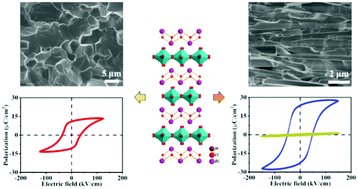Bi2WO6 lead-free ferroelectrics: microstructure design, polar behavior and photovoltaic performance†
Abstract
Bi2WO6 (BWO) is a promising ferroelectric material because of its high Curie temperatures and environmentally benign nature. However, the mica-like grain growth habit and large leakage current make it difficult to obtain excellent polar properties when preparing BWO bulk materials by a conventional route. Here, through the precursor morphology control, combined with spark plasma sintering (SPS), we prepared for the first time BWO ceramics with different microstructures: randomly oriented polyhedron grains (R-BWO) and highly aligned plate-like grains (T-BWO). Excellent polar properties are successfully obtained in both kinds of BWO ceramics. In particular, T-BWO ceramics exhibit a large remnant polarization (Pr) of ∼23.6 μC cm−2 and a piezoelectric coefficient (d33) of ∼18.2 pC N−1, almost twice that of the R-BWO ceramics. Moreover, bulk photovoltaic effect investigations indicate that the photovoltaic properties can be modulated through microstructure design, specifically, T-BWO has a short circuit photocurrent of ∼−1.50 nA, which is almost four times that of R-BWO. The underlying mechanisms are further demonstrated by crystal structure and microstructure analysis. This study provides a simple and feasible microstructure engineering approach to manipulate not only the ferroelectricity but also the photovoltaic properties of layer-structured materials.



 Please wait while we load your content...
Please wait while we load your content...